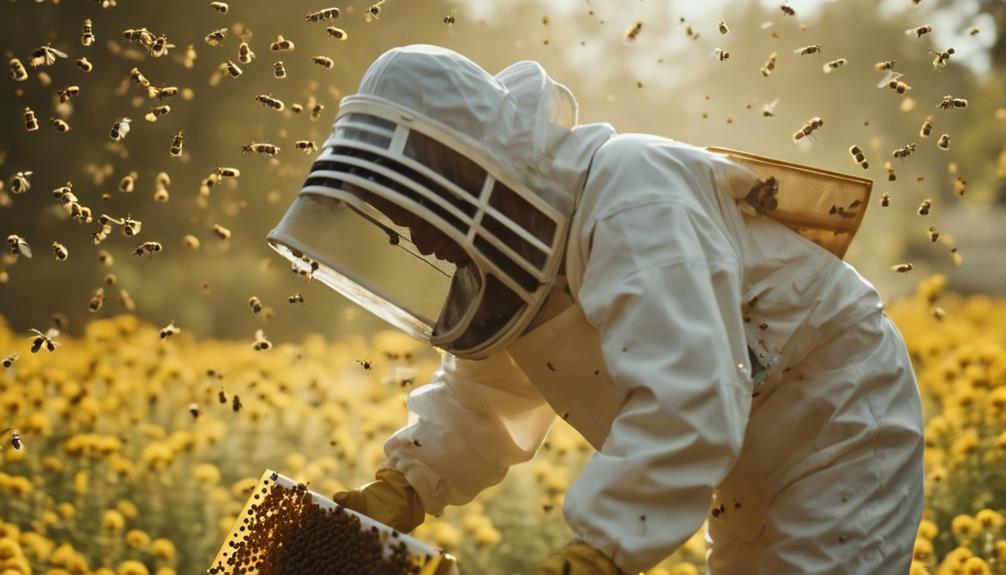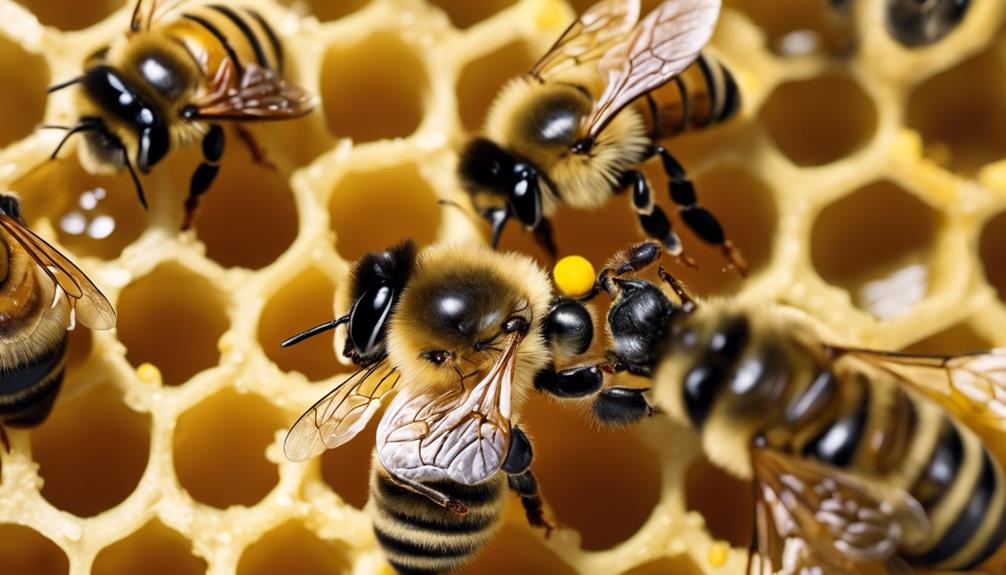Beekeeping maintenance levels vary, offering a range from low to intensive care, impacting bee colony health significantly. Low maintenance beekeeping involves minimal interfering, ideal for those seeking benefits without heavy time commitment. For more involved beekeepers, regular maintenance tasks like monitoring queen health and bee activity are essential to guarantee hive stability.
However, intensive maintenance requires frequent checks and effort for premium products like royal jelly and pollen. The key lies in balancing the time invested with the joys of beekeeping, guaranteeing equipment functionality for hive health. Delve into the nuances of beekeeping maintenance to discover how to best support your buzzing friends!
Main Points
- Beekeeping maintenance levels vary from low to intensive.
- Low maintenance options offer a hands-off approach.
- Regular maintenance involves moderate work for hive upkeep.
- Intensive maintenance demands constant attention and care.
- Balancing maintenance levels with personal commitment is essential.
Maintenance Levels in Beekeeping
When considering beekeeping, the maintenance levels vary from low to intensive based on the beekeeper’s objectives and level of involvement. Low maintenance beekeeping offers a hands-off approach, allowing bees to thrive naturally with minimal oversight. This is ideal for those seeking a more laid-back experience with occasional checks to guarantee the colony’s well-being.
On the other hand, regular maintenance, favored by many beekeepers, involves moderate work for honey and beeswax harvesting, requiring weekly or bi-weekly inspections. For dedicated beekeepers looking to produce items like pollen and royal jelly, intensive maintenance is the way to go, necessitating frequent colony checks every 2-3 days.
The time commitment varies significantly based on the maintenance level chosen, impacting both the beekeeper’s schedule and the overall health and productivity of the bee colony.
Factors Affecting Beekeeping Maintenance
Factors influencing the maintenance requirements in beekeeping include hive type, beekeeping practices, and seasonal tasks.
The type of hive you choose can impact how much time and effort you’ll need to dedicate to maintenance.
Different beekeeping practices, like how often you inspect the hive or manage pests, also play a role in determining maintenance levels.
Additionally, seasonal tasks such as harvesting bee products or preparing the hive for winter can affect the overall maintenance workload.
Understanding these factors is essential in managing your time effectively and ensuring your bees thrive. By considering these aspects, you can plan your hive maintenance routine to suit your preferences and goals in beekeeping.
Low Maintenance Beekeeping Benefits
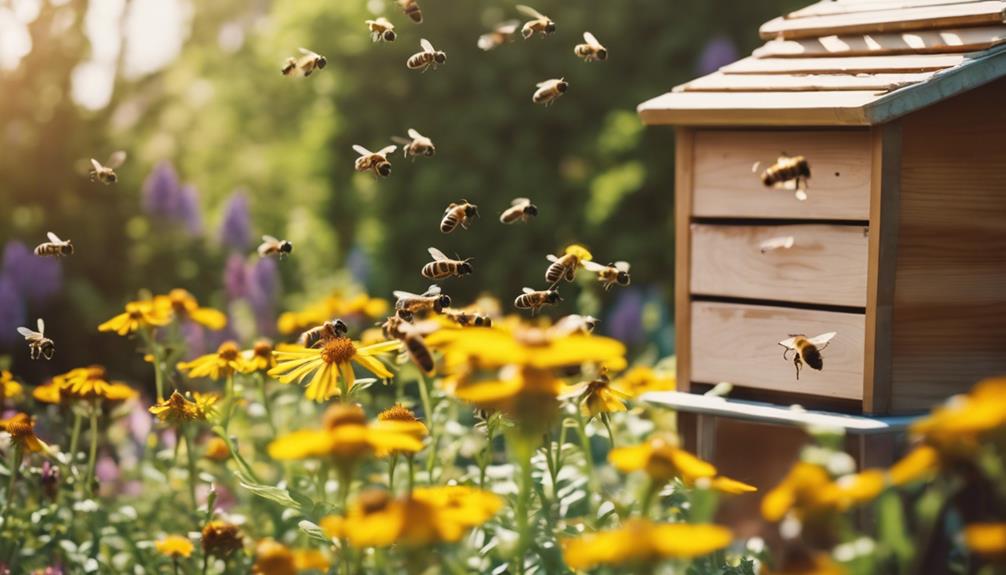
Low maintenance beekeeping offers a time-saving approach that simplifies hive management, allowing bees to thrive naturally with minimal interference.
The occasional checks required are manageable, and the lack of harvesting makes this method hassle-free for beekeepers.
It’s an ideal option for those seeking valuable benefits from beekeeping while keeping their time commitment to a minimum.
Time-Saving Beekeeping Tips
Are there practical ways to streamline beekeeping tasks while still ensuring the well-being of the bees? Absolutely! Here are three time-saving beekeeping tips for those who value efficiency and the freedom to enjoy beekeeping without high maintenance demands:
- Strategic Hive Placement: Positioning hives in areas with ample natural forage can reduce the need for supplemental feeding, allowing bees to thrive with minimal intervention.
- Use of Bee-Friendly Plants: Cultivating bee-friendly plants near the hives not only supports the bees’ nutrition but also decreases the necessity for frequent inspections and feedings.
- Smart Equipment Choices: Investing in time-saving beekeeping equipment like flow hives or hive monitoring systems can streamline tasks and provide valuable insights into hive health, minimizing the time beekeepers need to spend on routine checks.
Simplified Hive Management
To simplify hive management and welcome low maintenance beekeeping benefits, beekeepers can adopt strategies that promote natural bee behavior while minimizing intervention. By allowing native bees to operate with minimal interference, beekeepers can create a more hands-off approach to beekeeping.
This method doesn’t require frequent harvesting, only occasional checks on the bees’ well-being, supporting their health without intensive involvement. Low maintenance beekeeping is ideal for those seeking to support bee populations while minimizing the time commitment typically associated with traditional beekeeping practices.
Embracing this approach not only benefits the bees by allowing them to thrive naturally but also provides beekeepers with the freedom to enjoy the process without feeling overwhelmed by constant management tasks.
Regular Maintenance Tasks for Beekeepers
Regular hive maintenance entails conducting weekly or bi-weekly checks to guarantee bee health, safety, and sufficient honey stores. Here are three essential tasks beekeepers need to focus on:
- Monitoring Queen Health: Regularly checking on the queen bee ensures the hive’s stability and productivity.
- Checking Food Stores: Keeping an eye on honey and pollen reserves is vital to prevent starvation during lean periods.
- Observing Bee Activity: Monitoring the bees’ behavior helps in identifying any issues within the hive and addressing them promptly.
These routine tasks not only help maintain a thriving hive but also allow beekeepers to stay connected with their buzzing friends while safeguarding their well-being.
Intensive Maintenance Requirements
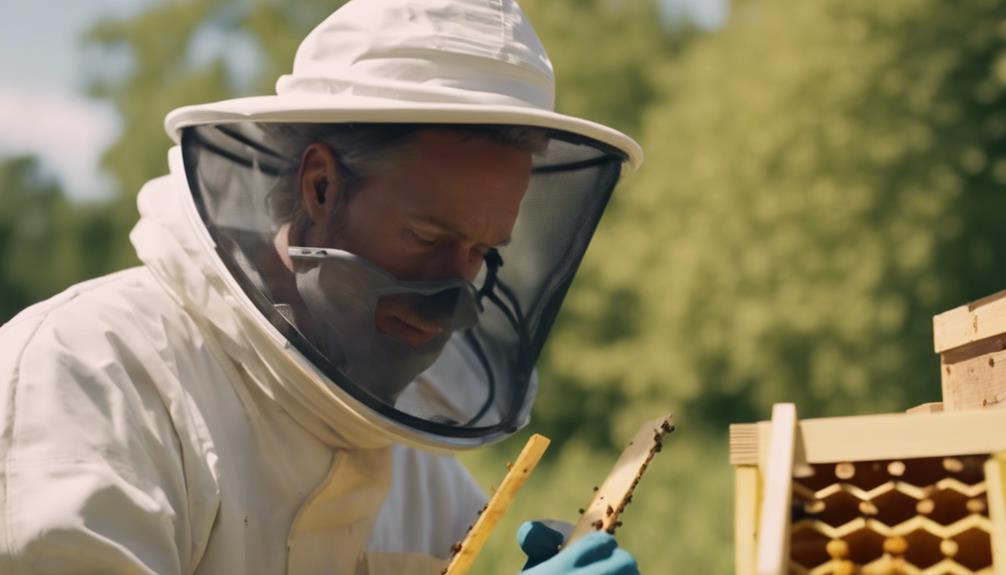
Maintaining beehives intensively requires us to be on top of things, checking colonies every 2-3 days to guarantee their well-being. As dedicated beekeepers, this level of commitment allows us to harvest valuable products like pollen and royal jelly while closely monitoring the health of our hives.
The time and effort invested in the regular upkeep of our equipment and the constant observation of hive conditions are vital aspects of intensive beekeeping maintenance.
Time Commitment for Beekeeping
Regularly engaging in intensive maintenance for beekeeping involves checking colonies every 2-3 days to guarantee ideal hive management. This commitment to hive health and productivity demands a significant time investment, but the rewards can be sweet. Here are three key points to take into account:
- Dedication: Beekeeping requires regular attention to make sure the well-being of the colony.
- Responsibility: Monitoring bee product levels is essential for maintaining a thriving hive.
- Time Management: Beekeepers must prioritize hive inspections to promote bee safety and productivity.
Balancing the time commitment with the joys of beekeeping is essential for those seeking a fulfilling experience with these industrious insects.
Equipment Maintenance Needs
In our beekeeping practice, we prioritize the maintenance of equipment to guarantee peak functionality and hive health. Regularly cleaning and inspecting our tools, such as smokers and hive tools, assures they’re free from beeswax buildup, which can hinder their effectiveness.
Well-maintained equipment not only helps us work efficiently but also promotes a healthy hive environment. By taking the time to care for our gear, we prevent any issues that could impact our bees’ well-being.
Monitoring Hive Health
Monitoring hive health at an intensive level involves checking colonies every 2-3 days to guarantee ideal conditions for the bees. This significant time commitment is essential for dedicated beekeepers who want to make sure their colonies thrive.
In terms of monitoring hive health, here are three key aspects to take into account:
- Regular Inspections: Checking for signs of disease, pests, and overall hive activity is vital for early detection and intervention.
- Product Levels: Monitoring honey and pollen stores, as well as royal jelly production, helps evaluate the hive’s productivity and well-being.
- Environmental Conditions: Observing factors like temperature, humidity, and ventilation can help maintain the best hive environment for the bees.
Time Commitment in Beekeeping
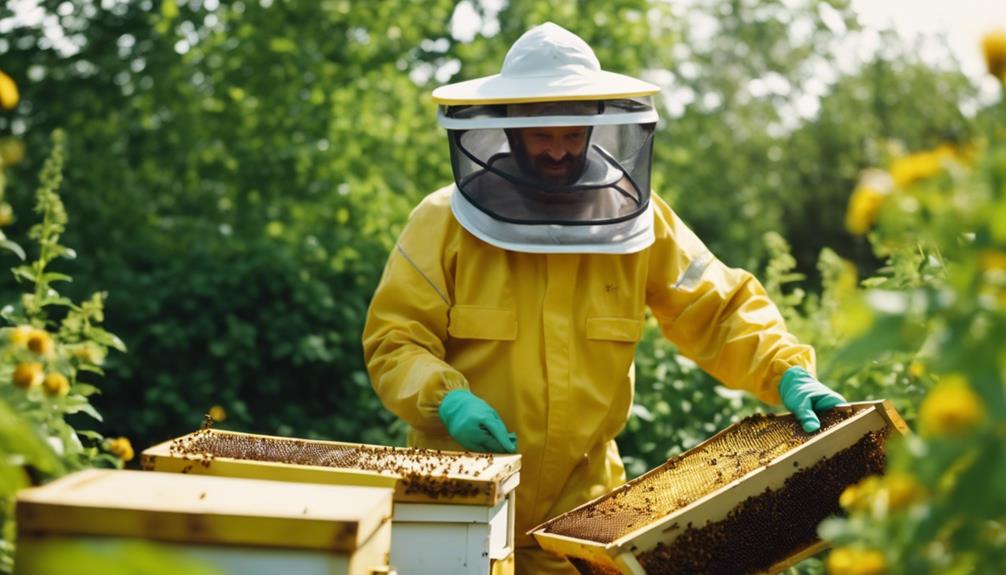
For urban beekeepers, staying on top of hive maintenance is essential to ensure the health of the colony and requires a dedicated time commitment. Beekeeping involves more than just placing hives in a garden and hoping for the best. It’s about understanding the needs of the bees, ensuring they’ve access to flowering plants for nectar, and regularly inspecting the hives.
Allocating time for learning about beekeeping through reading, classes, and online resources is pivotal. In the initial years, opening hives every two weeks is recommended to monitor colony activity closely. Remember, beekeeping demands more attention during the spring and fall, making it important to plan your time effectively to keep your bees thriving.
Hive Inspection Frequency
Regularly checking the hives is vital to guarantee the health and well-being of the bee colony. When it pertains to hive inspection frequency, especially during swarm season, here are some key points to ponder:
- Minimum Inspections: According to the Australian Honey Bee Industry Biosecurity Code of Practice, hives must be inspected at least twice a year for disease and pests.
- Swarm Season Vigilance: During swarm season, it’s recommended to inspect hives every 7-10 days to prevent or minimize swarming and ensure the colony’s stability.
- Record-Keeping Importance: Accurate documentation of hive inspections is essential for complying with regulations and industry standards, allowing you to track hive health and address any issues promptly.
Essential Beehive Maintenance Practices
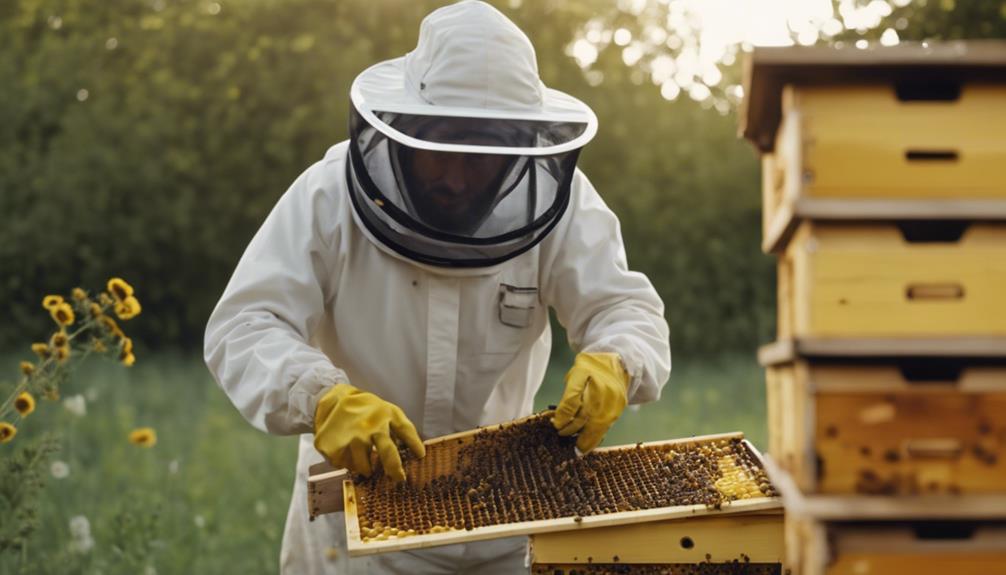
Maintaining the proper upkeep of beehives is crucial for preserving the health and productivity of the bee colony. Monitoring queen health is an essential part of hive maintenance, as she’s the core of the hive. Checking on her regularly guarantees a strong and thriving colony.
Varroa mite monitoring is another indispensable practice. These troublesome mites can cause chaos in a bee colony if left unchecked. By keeping an eye on mite levels and responding promptly, we can protect our bees from harm.
Tailoring Maintenance to Beekeeper Goals
Tailoring maintenance levels in beekeeping can vary from low to intensive depending on the beekeeper’s goals and commitment. When deciding on the level of maintenance for your bee colony, consider the following:
- Bee Species: Different bee species have varying needs and behaviors, impacting the maintenance required. Understanding your bees’ species-specific traits can help you tailor your approach to meet their needs efficiently.
- Successful Beekeeper: A successful beekeeper is one who aligns their maintenance efforts with their desired outcomes. Whether you aim for minimal intervention or maximum productivity, tailoring your maintenance to your goals can lead to a more fulfilling beekeeping experience.
- Personal Commitment: The level of maintenance you choose should align with your commitment level. Finding a balance that suits your lifestyle and goals will contribute to your success as a beekeeper.
Balancing Maintenance Efforts in Beekeeping
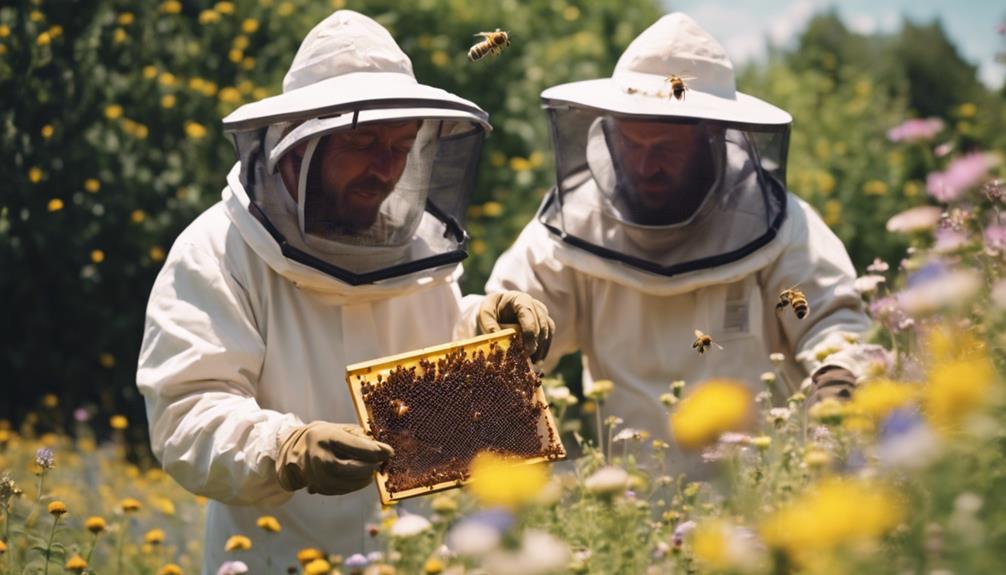
Maintaining a healthy balance in beekeeping involves juggling time commitments and caring for equipment efficiently.
Finding that sweet spot between dedication and practicality is key to sustaining a thriving beekeeping operation.
Time Commitment in Beekeeping
Balancing maintenance efforts in beekeeping requires dedicated time management and consistent monitoring of hive activity. In terms of time commitment in beekeeping, there are a few key points to keep in mind:
- Learning is Continuous: Allocate time to learn as much as you can about beekeeping through reading, classes, and online resources. The more you know, the better equipped you’ll be to care for your bees effectively.
- Regular Monitoring is Essential: Opening hives every 2 weeks in the beginning years is recommended. This routine allows you to observe colony activity closely and address any issues promptly, ensuring the health and productivity of your bees.
- Seasonal Demands: Spring and fall are particularly busy times in beekeeping, demanding more time commitment for essential hive management tasks. Be prepared to dedicate extra time during these periods to care for your bees effectively.
Equipment Care Tips
When caring for your beekeeping equipment, ensuring regular maintenance and cleanliness is essential to the overall health of your honey bee colonies. Regularly inspecting and cleaning your beekeeping gear helps maintain functionality and prevents contamination, ensuring a safe environment for your bees.
Storing equipment in a dry and secure location prolongs its lifespan and usability, while replacing worn-out or damaged items promptly is important for effective hive management. Properly sanitizing your beekeeping tools is necessary to prevent the spread of diseases among your bee colonies.
Organizing your supplies systematically not only streamlines hive maintenance tasks but also prevents misplacement, making your beekeeping experience smoother and more enjoyable. Remember, a well-cared-for beekeeping kit leads to happy and healthy bees!

Hello! My name is Noel Calvin. I graduated from UCLA and now work as a writer at Launch Ninjas. I write blog posts that inspire and guide our readers in their entrepreneurial pursuits. I live in Pleasantville, NJ, with a peaceful yet lively atmosphere that inspires me.
Writing stories is more than just a job for me. It allows me to share my observations and satisfy my curiosity about the world. I combine my analytical skills with creative enthusiasm to delve into technology trends and startup stories. But my life isn’t limited to screens and keyboards. I value loyalty, passion, and a touch of old-fashioned charm, which I infuse into every narrative I create.
I love spending time in my garage, jamming with my band when I’m not writing. Playing the guitar and singing bring me immense joy. I also enjoy capturing ordinary and extraordinary moments through my camera lens and exploring new culinary adventures that excite my taste buds. I’m always seeking new experiences.
My family is very important to me. Joyful Sunday brunches filled with laughter and intense board game nights keep me grounded, reminding me of life’s simple pleasures.
In my world, every moment is an opportunity for discovery. Every discovery is a story worth sharing, whether a heartfelt moment at home or the pulse of technological innovations. Join me as I navigate through life, one blog post, one guitar strum, and one heartwarming family dinner at a time.
